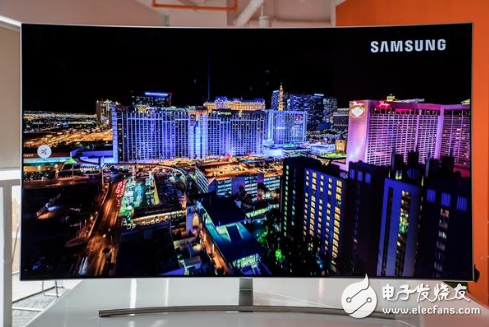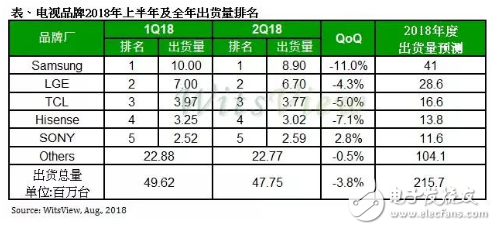According to the second quarter data released by WitsView, in terms of quarter-on-quarter growth, in addition to Sony’s growth, the top five TV companies have experienced declines. Among them, Samsung TV has the largest decline, and Samsung is also facing the problem of TV technology. The choice is that most of the world's TV companies are investing in LG's OLED camp, and Samsung's QLED TV technology route is gradually falling into a disadvantaged position.

Since 2016, the global TV panel supply has been tight, which has led to the continuous increase in TV panel prices. TV companies have tried their best to ensure a stable panel supply. However, Samsung has encountered the unfavorable situation in which Sharp stopped supplying TV panels (Sharp was acquired by Hon Hai in 2016. Hon Hai regards Samsung as an important competitor, and at the same time, it hopes to revive the Sharp brand TV business, so it made this decision), forcing it to seek cooperation with long-term rival LG, which led to Samsung TV’s launch in 2017 The shipment volume fell by about 1% year-on-year, which was the only one among the top five TV companies that saw a decline in shipment volume.
Beginning in the second half of 2017, the global TV panel supply and demand situation has reversed, from insufficient supply to oversupply, and TV panel prices continue to fall. This has provided opportunities for Chinese TV companies that have always emphasized cost-effective advantages. Since then, Chinese TV companies have frequently launched Price war.
Chinese TV companies frequently launch price wars are actually a last resort. Internet TV companies such as LeTV continue to challenge traditional TV companies with cost-effectiveness as a competitive advantage. Traditional TV companies continue to achieve an increase in market share. Once ranked among the top four domestic TVs, LeTV is recognized by LeTV. After the impact of financial problems, Xiaomi took over the banner of Internet TV and continued to wave the banner of cost-effectiveness. In the second quarter of this year, some organizations even believed that Xiaomi had achieved the first market share in the domestic TV market, which forced traditional TV companies to join in this event. In the price war, Chinese TV companies continue to grab market share in the low-end market by virtue of their cost-effective advantages.
In the high-end TV market, Samsung mainly promotes QLED TVs, while LG mainly promotes OLED TVs. In the early two years, QLED TVs had won the lead, but last year, OLED TVs successfully fought back and won more than 50% of the market share in the high-end TV market. According to data released by IHS in the first quarter of this year, Samsung’s QLED TV shipments fell 45% year-on-year, while LG’s OLED TV shipments increased 84% year-on-year.
The mid-to-low-end TV market was severely impacted by Chinese TV companies, and it was unable to compete with LG's OLED TVs in the high-end TV market, which ultimately led to a quarter-on-quarter decline in Samsung's TV shipments by 11%, a decline among the top five TV companies. The biggest result.

In terms of TV technology, Samsung chose QLED TV technology, hoping to rely on the advantages of QLED TV’s wide color gamut and long life to defeat LG’s OLED TV technology. However, more than a dozen TV companies around the world have chosen OLED TV technology (previously). Among the five major TV companies, LG, Hisense, and Sony have chosen OLED TVs), and OLED TVs have achieved a competitive advantage in the high-end market, QLED TV technology is at a disadvantage.
However, Samsung seems unwilling to give up QLED TV technology. It is said that it is actively developing self-luminous QLED TV technology. However, it will take several years for self-luminous QLED TV technology to reach economic costs; in contrast, LGD is in Guangzhou. To build a production line for OLED panels for 8.5-generation TVs. The two major Chinese panel companies are also developing OLED panel technology for TVs. As the production capacity of TV OLED panels continues to increase, the cost will be further reduced. The competitive advantage of TV.
Samsung actually intends to develop OLED panels for TVs. It is the leader of small and medium-sized OLED panels and has strong OLED panel technology. However, in 2016 it decided to abandon this plan and continue to increase its R&D investment in QLED TV technology. Chance to catch up with LG.
In terms of TV technology, Samsung is also betting on microLED, which is regarded as a replacement for OLED technology. At CES2018 at the beginning of this year, it exhibited the world's first microLED TV-146-inch The Wall, which shows that it possesses TV technology. The leading advantage is that it will take several years for the same microLED panel to reach the economic cost stage of mass production.
If OLED TVs become mainstream in the TV market in the next few years-this can basically be considered a reality. Samsung will be at a disadvantage in TV technology. The lack of competitive advantage in TV technology competition will have an adverse impact on Samsung TVs. LG is obviously more advantageous. Witsview estimates that Samsung’s TV shipments this year will be 41 million, down 14.4% from 47.9 million in 2016; it estimates that LG’s TV shipments this year will be 28.6 million, an increase of 1.4 from 2016’s 28.2 million. %, the shipment gap between the two TV companies is shrinking.
With Push-in connection technology, you can connect conductors easily – both directly and without tools, insert forces reduced by 50%. it is suitable for various applications. Insert rigid conductors or conductors with ferrules from 0.25mm² into the conductor shaft.The contact spring opens automatically and provides the required pressure force against the current bar.
When installing smaller conductors from 0.14mm², use a standard screwdriver to push the orange button and actuate the contact spring.
Push-in Connection have test and passed various certificates. For example, Vibration resistance in accordance with railway standard DINEN50155,shock and corrosion resistance in accordance with current shipbuilding registers.
Spring Push Terminal Block,Spring Loaded Terminal Block,Twin Terminal Block,Twin Spring Terminal Block
Wonke Electric CO.,Ltd. , https://www.wkdq-electric.com
